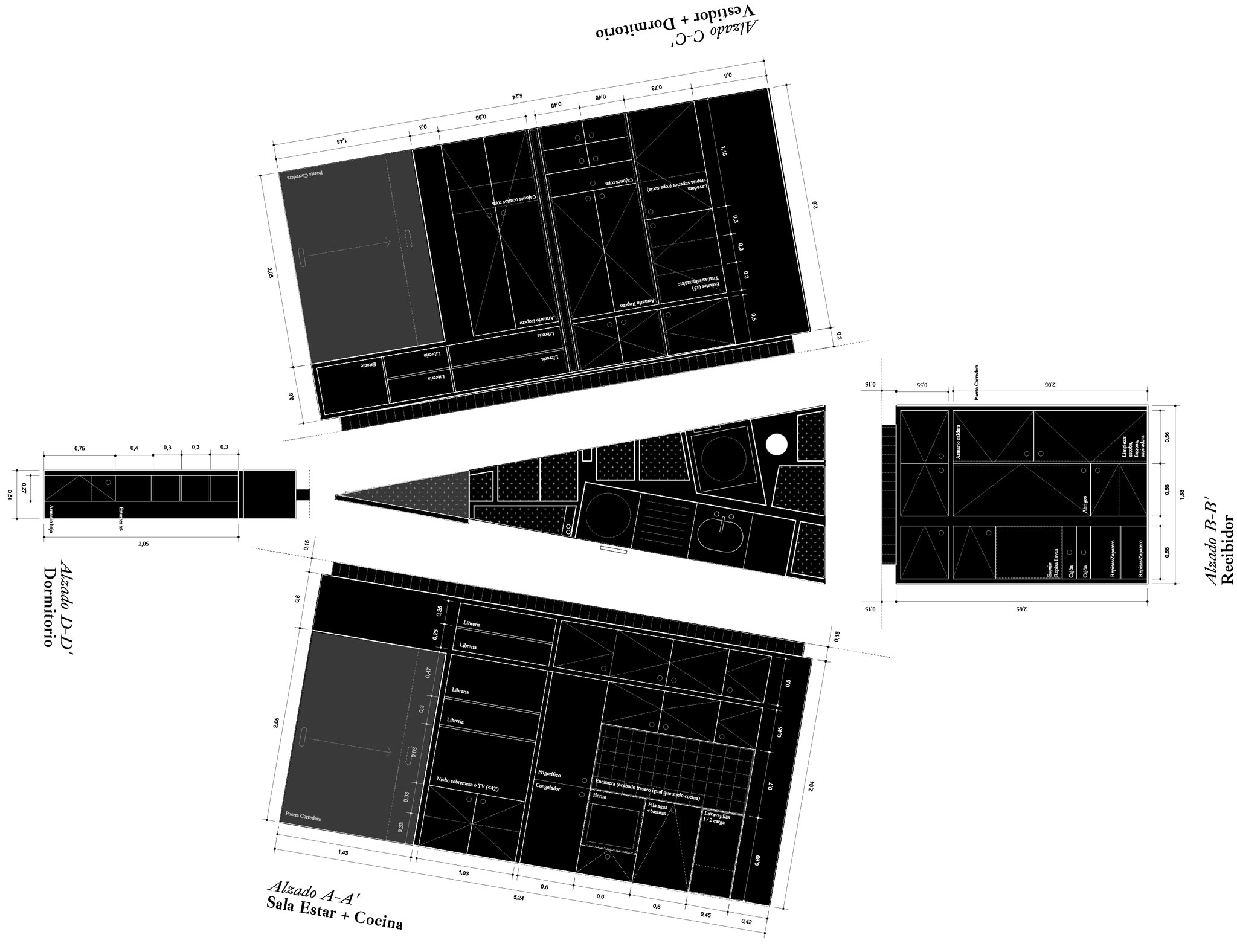
The renovation proposed by Pedro Pitarch allows for a series of events that depend on the implemented device, which aims to serve to generate a reflection on everyday life, which recalls Henri Lefebvre's Critique of Everyday Life, which was first published in 1948 (Critique de la vie quotidienne), revised in 1968 (La vie quotidienne dans le monde moderne) and again in 1981 (Critique de la vie quotidienne, III: De la modernité au modernisme).
Lefebvre's work, in itself, is already a demonstration of the futility of establishing a critique on such a permanent and at the same time so futile issue. This is seen in the attempt to emancipate the domestic by eliminating an architecture "from the restrictions of spatial distribution" that is once again trapped by a triangular piece of furniture, a new architecture that assumes the role of spatial infrastructure, temporarily responding to the needs of the client.

Model. Renovation in Malasaña by Pedro Pitarch.

Device. Renovation in Malasaña by Pedro Pitarch.
Project description by Pedro Pitarch
This article is written to be read in sync with track 1 (Shine on You Crazy Diamond pts. 1-5) from the album Wish You Were Here by Pink Floyd (London, 1975).
The minutes corresponding to each fragment have been indicated as a mere temporal reference.
[00:01-08:58]
Remember when you were young, you shone like the sun.
Shine on you crazy diamond.
Objects, and not architecture, construct contemporary domesticity.
Distribution, composition and the correlation between an architectural piece and its function, a condition invented by modernity, have ceased to coordinate the efforts that generate the domestic sphere.
In a pre-modern state of domesticity, it was furniture that generally defined the domestic events that constructed the idea of home, and not its division into pieces, which, together with their zoning and programmatic specialization, has implanted for more than a century a planetary homogenization of the routines of daily life.
[08:59-09:20]
Now there's a look in your eyes, like black holes in the sky.
Shine on you crazy diamond.
The reinvention of everyday practices, inherited, assumed and imposed, seems to be one of the few possible forms of social revolution in the era of post-capitalism. The design of new architectural formats that propose contextual frameworks, places of opportunity, outside the restrictions of a domesticity inherited from modernity is crucial for the possible reinvention of the everyday life. The architectural piece that has been inserted here within a conventional home aims to reorganize its eventual domesticity around a Device for the Critique of Everyday Life, following what Henri Lefebvre pointed out.

[09:21-10:04]
You were caught on the crossfire of childhood and stardom,
Blown on the steel breeze.
Come on you target for faraway laughter,
Come on you stranger, you legend, you martyr, and shine!
The architectural operation is purely strategic. We have proposed a typological abstraction of the plan of a conventional home by means of implanting a purely geometric element that contains all the mechanisms, installations and objects necessary to construct the domestic sphere. An architectural device that brings together, folds and unfolds domestic events.
The domestic realm is emancipated from the restrictions of spatial distribution, from the restrictions of material sophistication or even from the restrictions of inherited customs and habits.
Domesticity is reduced to pure infrastructure. The different daily programs, derived from the needs of the owner, are embedded in a triangular piece of furniture that assumes the infrastructural role of the project.
There is no architecture beyond the infrastructure, which behaves as a device capable of activating domestic events in the areas adjacent to each side of the device.
[10:05-10:23]
You reached for the secret too soon, you cried for the moon.
Shine on you crazy diamond.
The heterogeneity of infrastructures that the piece condenses is balanced by an almost generic homogeneity of its finish: brushed aluminium. Only the two countertops, the island and the kitchen, are made with continuous pieces of recycled stainless steel due to their resistance to aggressive use.
The only piece separated from the central triangular prism is an island with a circular geometry, which functions as a kitchen element, storage and dining table.

[10:24-10:45]
Threatened by shadows at night, and exposed in the light.
Shine on you crazy diamond.
The hyper-densification of infrastructure requires a second decision: to reduce any other potential architectural intervention to the finishes. To do this, the project plan traces three parallel bands that are crossed by the geometry of the triangle. Two warmer stripes are made of wood and a third harder one is made of single-layer terrazzo in the central area. Three bands suggest either resting and meeting programs to be displayed over the warm areas or cooking and hygiene uses over the cold areas.
The ceiling plane is resolved with the same condition of homogeneous abstraction of the rest of the apartment, using a perforated acoustic ceiling that incorporates, as a secondary type of hole, an adjustable recessed system of lights that are distributed homogeneously according to the multipurpose requirement of the space below it.
[10:46-13:30]
Well you wore out your welcome with random precision,
Rode on the steel breeze.
Come on you raver, you seer of visions,
Come on you painter, you piper, you prisoner, and shine!
The domestic infrastructure, prisoner of the triangular geometry, is an architectural oxymoron that emancipates the daily routines by generating escape lines from everyday life.
It is precisely the domestic events, generated around the infrastructure of the inserted architectural device, the ones that construct a revised condition of domesticity and, ultimately, of the home.


























































